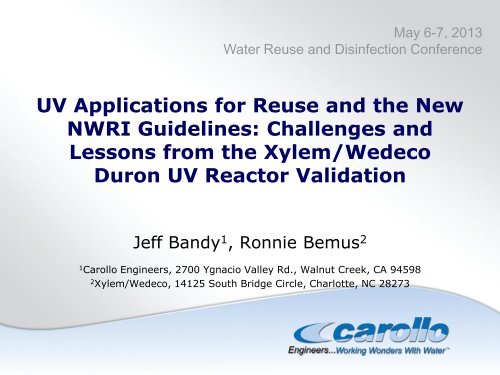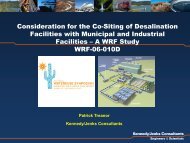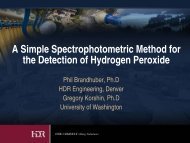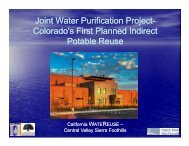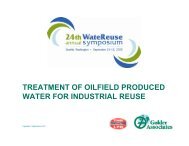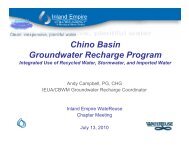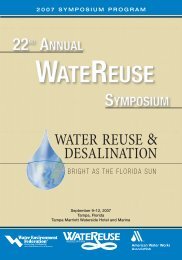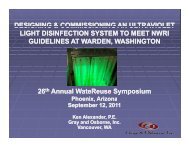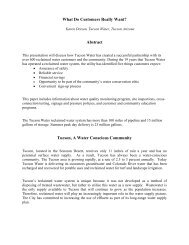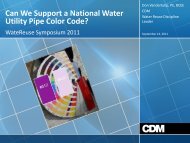UV Applications for Reuse and the New NWRI Guidelines ...
UV Applications for Reuse and the New NWRI Guidelines ...
UV Applications for Reuse and the New NWRI Guidelines ...
Create successful ePaper yourself
Turn your PDF publications into a flip-book with our unique Google optimized e-Paper software.
Most reuse <strong>UV</strong> applicationsfollow <strong>NWRI</strong> <strong>UV</strong> Guidance
Background to <strong>UV</strong> ReactorValidation Testing
Influent <strong>and</strong> effluent samplesdetermine log inactivationThe log inactivation of a tested microbe is translated to a<strong>UV</strong> “dose”, based on <strong>the</strong> <strong>UV</strong> inactivation kinetics of <strong>the</strong>microorganism
Dose Monitoring viaCalculated Dose Algorithm
Third Ed. published in 2012
Third Ed. published in 20121. Drinking Water2. <strong>Reuse</strong> Water3. Protocolsa. MS2 dose-responseb. Checkpoint bioassayc. Data analysis
2 nd Ed.: MS2 dose-responsePrevious <strong>NWRI</strong> <strong>Guidelines</strong> defined quality control bounds
Carollo: MS2 quality boundsCorroborated by
3 rd Ed.: MS2 dose-response<strong>New</strong> guidelinesdefine a priori doseresponsebehavior<strong>for</strong> MS2 phageCensoring 150 mJ/cm 2removes valid data(25% of data inDuron example) butallows <strong>for</strong> <strong>the</strong>assumption oflinearity
3 rd Ed.: Bioassays replacevelocity profilingTheoretical scale-up (velocity profiling) replaced byper<strong>for</strong>mance-based scale-up (checkpoint bioassay testing)Mahar et al.,WEFTEC2006Reliable <strong>UV</strong> disinfection requires more than good hydraulics!
<strong>NWRI</strong> Checkpoint BioassayRequirementso Installed system must provideminimum RED in at least 7 out of8 bioassay test conditionso MS2 bacteriophageo Demonstrate doses ofo 100 mJ/cm 2 (media filtered)o 80 mJ/cm 2 (MF effluent)o 50 mJ/cm 2 (RO effluent)o <strong>UV</strong> doses meet Title 22requirements, based on a 5-logpoliovirus inactivation goalstemming from <strong>the</strong> PomonaVirus Study (LACSD, 1977)oooNon-infectious virus(+)ssRNA30 nm φ
2 nd Ed.: Data analysis & sizing2003 <strong>NWRI</strong>
3 rd Ed.: Data analysis & sizingCapacity is defined by incorporating a “confidenceratio” based on validation testing, goodness of fitRED 0. 831<strong>NWRI</strong> REDpred
Xylem/Wedeco Duron Validation
WEDECO Duron <strong>UV</strong> SystemOpen-channel wastewater disinfection systemModular banks of twelve 600 W LPHO lampsReliable on-line <strong>UV</strong> intensity sensors <strong>for</strong> accurate <strong>UV</strong> dosepacingExtensive validation ef<strong>for</strong>t includes MS2, T1<strong>UV</strong>, T7 phage,B. pumilus sporesDirect measurement of additive bank effects, compared toprevious open-channel <strong>UV</strong> systems that assume perfectbank additivity
Minden WWTP Pilot
Photos of Minden test site
Photos of Minden test site
Snapshot of test matrix:Validated range envelopes
Duron: <strong>NWRI</strong> 2 nd Ed. Analysis
Duron: <strong>NWRI</strong> 3 rd Ed. Analysis2 nd Ed.: ~7 mJ/cm 2 offset. 3 rd Ed.: 0.92 confidence ratio.
Vendor B: <strong>NWRI</strong> 2 nd Ed. Analysis
Vendor B: <strong>NWRI</strong> 3 rd Ed. Analysis2 nd Ed.: ~7 mJ/cm 2 offset. 3 rd Ed.: 0.83 confidence ratio.
Underst<strong>and</strong>ing bank additivityCD<strong>UV</strong>AE<strong>UV</strong>ABasing your design on Sbioassay-validated data helps avoid2AB <strong>UV</strong>AS 0GH<strong>UV</strong>AI<strong>UV</strong>Adangerous log i 10<strong>UV</strong>Aassumptions be<strong>for</strong>e attempting Modules checkpointbioassays (e.g., assuming Q DLperfect bank additivity)2
What’s missing from <strong>NWRI</strong><strong>Guidelines</strong>, 3 rd Ed.System sizing <strong>and</strong> operations depend on:• <strong>UV</strong>T (%): measurement of <strong>the</strong> <strong>UV</strong>A 254• Flowrate: average, max daily, etc.• Footprint or power limitations guide lamptechnology lamp choice (LP vs. MP)• Pretreatment: High SRT during secondarytreatment <strong>and</strong> good filtration reduces <strong>the</strong>fraction of particle-associated coli<strong>for</strong>mBut what use is good design if <strong>the</strong> systemisn’t adequately monitored?
<strong>UV</strong>DGM provides clearguidance re: online <strong>UV</strong> sensorsin WTPsEach reactor must have at least oneonline germicidal <strong>UV</strong> sensor to monitorlamp outputDuring validation, online <strong>UV</strong> sensors mustbe within 10% of reference sensorsDuring operation, online sensors must bewithin 20% of reference sensors,measured at least once a month
<strong>NWRI</strong> <strong>Guidelines</strong> require <strong>UV</strong>intensity monitoring…Under “Monitoring <strong>and</strong> Alarm Design”
…but some <strong>UV</strong> disinfection systemsdo not adequately include <strong>UV</strong> sensorsignals in <strong>UV</strong> dose pacingRudimentary <strong>UV</strong> dose algorithm in <strong>UV</strong>DGMuses inputs of <strong>UV</strong> absorbance, flow (Q),number of banks (B), <strong>and</strong> relative <strong>UV</strong>sensor intensity (S/S o ) to “dose-pace” <strong>the</strong>reactorNo similar requirement in <strong>NWRI</strong> <strong>Guidelines</strong>
Sleeve fouling at WWTPimpairs <strong>UV</strong> disinfectionUncleaned sleeves (L)Cleaned sleeves (R)Livermore, CA <strong>UV</strong> PLCdisplayed equal <strong>UV</strong>doses <strong>for</strong> eachWhat can engineers<strong>and</strong> utilities do when<strong>the</strong> design <strong>UV</strong> dose ≠<strong>the</strong> actual <strong>UV</strong> dose?
Benefits of Online <strong>UV</strong> Sensorso Real-time dosemonitoring, facilitatingmaintenanceo Full control ofmaintenance scheduleo True measurement ofdoseo Optimizes energy useo Not all systems use <strong>the</strong>m,but <strong>the</strong>y are stronglyrecommended
CAF Index Uses <strong>UV</strong> Sensors toMonitor Lamp Aging/Fouling“Combined aging <strong>and</strong> fouling factor” (CAF) is <strong>the</strong> ratioof <strong>the</strong> measured <strong>UV</strong> sensor intensity to <strong>the</strong>predicted <strong>UV</strong> sensor intensity with new lamps <strong>and</strong>sleevesOnline <strong>UV</strong> sensor measurementSCAFS pSP10AexpB<strong>UV</strong>TPCReal-time monitoring of lamp aging <strong>and</strong> sleeve fouling,proactive maintenance, warranty guarantees
ConclusionsConsultants <strong>and</strong> vendors need to be awareof balance between accurate validationtesting, conservative sizing, <strong>and</strong> worry-freecheckpoint bioassay testingDifferences between 2 nd <strong>and</strong> 3 rd Ed. dependon <strong>the</strong> equipment, quality of validationtesting, <strong>and</strong> design goalBoth previous <strong>and</strong> current <strong>NWRI</strong> <strong>Guidelines</strong>provide good guidance <strong>for</strong> robustdisinfection of reuse water
Thank you!jb<strong>and</strong>y@carollo.com


